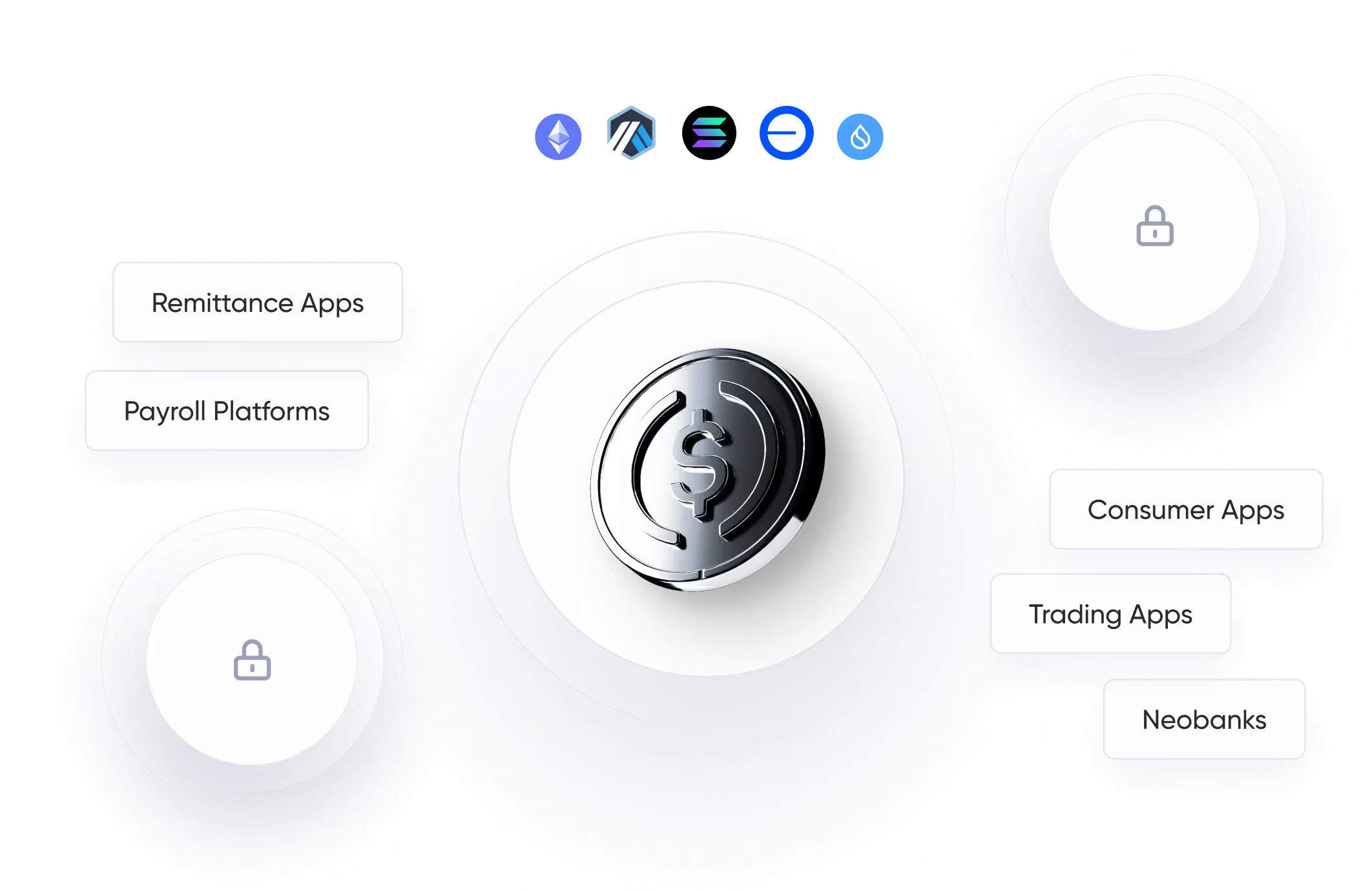Big news! Dynamic is now part of Fireblocks.
Email, Social & Embedded Wallets
Embedded wallets even your grandparents can use
Spin up flexible, non-custodial embedded wallets, and focus on building experiences that matter. Abstract the complexity of crypto away from users, and onboard them with familiar UX.
Available on

EVM

SVM

Sui

Bitcoin
Soon
As easy as LEGO blocks
Embedded wallets might not be as cool as legos, but we made them just as simple to use.
Non-custodial
Passkeys gate access to users' wallets, enabling only them to sign transactions.
Optimized for your users
Your users sign in just as they would to any other web2 website.
Launch global Stablecoin Accounts in days, not months
Build and go to market with stablecoin-powered payments and accounts faster, more securely, and without the complexity.
Learn more


Supported by the biggest blockchains
Invisibly create non-custodial wallets across blockchains. Build dApps for Web3-natives and Web2 customers alike.
Try it yourself
Stocked full of powerful, and customizable features
Pre-generated wallets API
Facilitate ERC-20 token interaction without logins. Generate non-custodial wallets programmatically through email addresses, triggering deposits on app engagement.
Integrated on-ramps & off-ramps
Help your customers get crypto instantly with a single-click from our dashboard.
Multiple security Methods
Secure your wallet seamlessly with FaceID or a password manager. Choose familiar options like email codes for added security.
Enterprise-grade wallets, powered by TSS-MPC
No single point of failure
By distributing key shares across multiple parties, TSS-MPC eliminates the risk of a single compromised device or server leading to total key exposure.
Protection during signing
MPC ensures that the private key is never fully assembled during transaction signing, reducing exposure to keylogging or memory-based attacks.
Customizable thresholds
Organizations can set different thresholds for key reconstruction, balancing security and usability according to their specific needs.
Security with TEEs
Combining MPC with Trusted Execution Environments (TEEs) further enhances security by executing computations in hardware-isolated environments.
What Makes TSS-MPC Different
Discover how Dynamic’s TSS-MPC provides stronger security than Shamir Secret Sharing, legacy MPC, or other approaches that create a full private key.

TSS-MPC
TSS-MPC
Legacy
TSS-MPC
TSS-MPC
Shamir
Secret Sharing
SSS
TEE-Only
Full Private Key
TEE Only
No Single Point of Failure




No Full Key Ever Exists



Reconstructed during signing

Full key exists server side
Distributed Signing




Threshold Support (t-of-n)



More limited than MPC

Reshare Without Keys




Signing Latency

Sub-second signing

5-10 second signing

Moderate

Fast local signing
Key / Account Recovery

If above threshold

If above threshold

If above threshold

Key undecryptable if enclave lost
Regulatory Comfort / Auditability

Easier to reason about distributed trust and non custody

Easier to reason about distributed trust and non custody

Depends on the implementation

Full private key is stored server side
Use of TEEs





Enable superpowers with gas sponsorship
We’ve built a native integration with multiple AA partners to make smart contract accounts seamlessly fit into your app.
Gas sponsorship
Session keys
Batch transactions
Read our documentation
PWA-focus experience
We spent time optimizing Dynamic to mobile flows, leveraging passkeys for easy FaceID and TouchID login and wallet creation.
Cross-platform compatible
Protects against phishing
Feels like a native experience
Try it yourself


All the Web2 auth methods your heart desires
Need a login method? We’ve got you covered.Don’t need one? I guess we also have you covered...
& many more..
Already have a wallet-as-a-service provider? That works!
Use Dynamic’s auth solution, authorization tools, and user management system
alongside leading wallet-as-a-service providers.



What is TSS-MPC?
TSS-MPC, or Threshold Signature Scheme with Multi-Party Computation, is a cryptographic method that allows multiple parties to jointly generate a single digital signature, enhancing security by distributing the signing power among participants without revealing the private key to any single party.
What is an Embedded Wallet?
You can think of an embedded wallet like a powerful web-account. An embedded wallet is a programmable web3 crypto wallet that can be issued invisibly to customers on your website. Customers with an embedded wallet can immediately receive digital tokens and make on-chain interactions without needing to go through the complexities of understanding the intricacies of typical EOA wallets like metamask or Phantom.
What are passkeys?
Passkeys are a new type of passwordless authentication designed to be more secure and convenient than traditional passwords. They are based on the Web Authentication (WebAuthn) standard, which uses public key cryptography to create a secure link between a user’s device and a website or app. They were developed by the FIDO alliance (made up of companies like Apple, Google, Microsoft, Amazon, 1Password, among others).
Unlike traditional passwords, which create friction and pose phishing risks, passkeys leverage a familiar pattern of using a biometric (FaceID, or TouchID) to securely create and store a credential to the user’s device.
How is Dynamic using passkeys?
Dynamic uses passkeys as a security method to authenticate and gate access to embedded wallet private keys. Specifically, passkeys are used to ensure that your users are in control of their private keys by leveraging secure enclaves. By simple analogy, passkeys and secure enclaves are similar to a safety deposit box vault. That is, your end users have a key to access their locked box (i.e., wallet), while enjoying the benefits of having the box secured with vault-level security. The safety deposit box is inside the vault, but only the end user, with their key, can access the contents inside the box. After authenticating via email or social, users are prompted to create a passkey with their device (e.g., biometrics). This grants them a wallet and enables transaction signing with that passkey. The wallet’s private key is encrypted at rest, and only decrypted within secure enclaves with a signature from the user’s passkey.
How does recovery work?
Please refer to our recovery guide here.
Are embedded wallets custodial or non-custodial?
Our embedded wallet offering is non-custodial.
Can I pair this with Account Abstraction?
Yes! Instead of spinning up an EOA wallet, you can leverage our account abstraction integrations from providers such as ZeroDev to turn your wallet into a smart contract wallet. Read more in the AA guide.
How do passkeys protect against sim swapping and phishing attempts?
Passkeys come with multiple built in security benefits. Specifically, unlike a password or passcode, a user doesn’t have to remember information with a passkey, and that information can’t be phished from the user. In addition, because passkeys are tied to your iCloud or Google accounts, they are protected by Apple and Google’s security. Even if your sim gets swapped, an attacker would farther have to gain access to your iCloud account or Google keychain in order to get access to your passkey.


